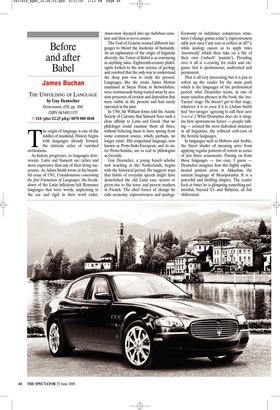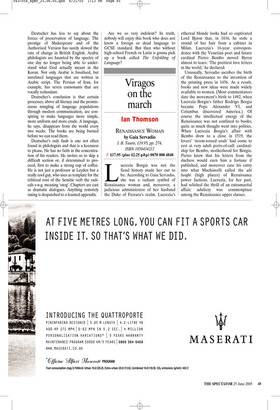Before and after Babel
James Buchan
THE UNFOLDING OF LANGUAGE by Guy Deutscher Heinemann, £20, pp. 360, ISBN 0434011355 ✆ £18 (plus £2.25 p&p) 0870 800 4848 The origin of language is one of the riddles of mankind. History begins with languages already formed, the intricate relics of vanished civilisations.
As history progresses, so languages deteriorate. Latin and Sanscrit are richer and more expressive than any of their living successors. As Adam Smith wrote in his beautiful essay of 1761, Considerations concerning the first Formation of Languages, the breakdown of the Latin inflexions left Romance languages that were wordy, unpleasing to the ear and rigid in their word order. Amaveram decayed into ego habebam amatum and then io aveva amato.
The God of Genesis created different languages to thwart the insolence of humanity. As an explanation of the origin of linguistic diversity, the Tower of Babel is as convincing as anything since. Eighteenth-century philologists looked to the new science of geology and resolved that the only way to understand the deep past was to study the present. Languages, like the strata James Hutton examined at Siccar Point in Berwickshire, were continuously being wasted away by aeonian processes of erosion and deposition that were visible in the present and had surely operated in the past.
In 1786, Sir William Jones told the Asiatic Society of Calcutta that Sanscrit bore such a close affinity to Latin and Greek ‘that no philologer could examine them all three, without believing them to have sprung from some common source, which, perhaps, no longer exists’. His conjectural language, now known as Proto-Indo-European, and its sister Proto-Semitic, are as real to philologists as Geordie.
Guy Deutscher, a young Israeli scholar now teaching in the Netherlands, begins with the historical period. He suggests ways that habits of everyday speech might have demolished the old Latin case system or given rise to the tense and person markers in French. The chief forces of change he calls economy, expressiveness and analogy. Economy or indolence compresses structures (‘change gonna come’); expressiveness adds new ones (‘any teas or coffees at all?’); while analogy causes us to apply rules ‘incorrectly’ which then take on a life of their own (‘suburb’ ‘paninis’). Presiding over it all is a craving for order and elegance that is spontaneous, undirected and permanent.
That is all very interesting, but it is just to soften up the reader for the main push which is the languages of the prehistorical period: what Deutscher terms, in one of many tasteless phrases in the book, the ‘meTarzan’ stage. He doesn’t get to that stage, whatever it is or even if it is. (Adam Smith had ‘two savages’ agreeing to call their cave ‘c-a-v-e’.) What Deutscher does do is imagine how spontaneous forces — people talking — created the most diabolical structure in all linguistics, the triliteral verb-root of the Semitic languages.
In languages such as Hebrew and Arabic, the finest shades of meaning arise from applying regular patterns of vowels to series of just three consonants. Passing on from these languages — too easy, I guess Deutscher imagines how this highly sophisticated pattern arose in Akkadian, the ancient language of Mesopotamia. It is a powerful and thrilling chapter. The reader feels at times he is glimpsing something primordial, beyond Ur and Babylon, all but obliterated. Deutscher has less to say about the forces of preservation of language. The prestige of Shakespeare and of the Authorised Version has surely slowed the rate of change in British English. Arabic philologists are haunted by the spectre of one day no longer being able to understand what God actually meant in the Koran. Not only Arabic is fossilised, but unrelated languages that are written in Arabic script. The Persian of Iran, for example, has seven consonants that are vocally redundant.
Deutscher’s conclusion is that certain processes, above all literacy and the promiscuous mingling of language populations through modern communication, are conspiring to make languages more simple, more uniform and more crude. A language, he says, disappears from the world every two weeks. The books are being burned before we can read them.
Deutscher’s only fault is one not often found in philologists and that is a keenness to please. He has no faith in the concentration of his readers. He invites us to skip a difficult section or, if determined to proceed, first to make a strong cup of coffee. He is not just a professor at Leyden but a really cool guy, who uses as template for the triliteral root of the Semitic verb the radicals s-n-g, meaning ‘snog’. Chapters are cast as dramatic dialogues. Anything remotely taxing is despatched to a learned appendix. Are we so very indolent? In truth, nobody will enjoy this book who does not know a foreign or dead language to GCSE standard. But then who without high-school French or Latin is gonna pick up a book called The Unfolding of Language?



































































 Previous page
Previous page